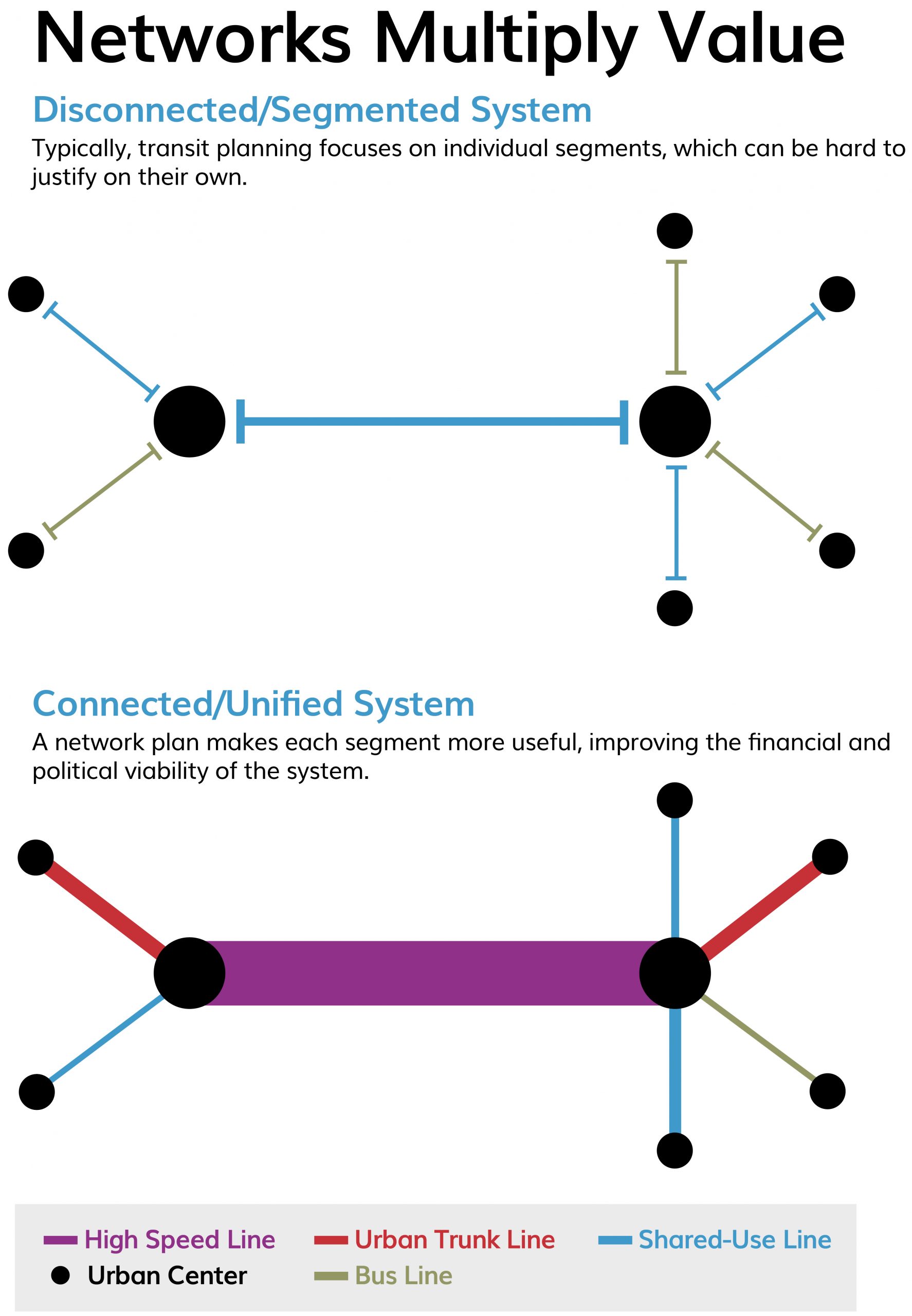Reinventing the way the United States does transportation
Posted: 4 November 2020 | Rick Harnish | No comments yet
The High Speed Rail Alliance is driving the conversation for high-speed trains across North America. Executive Director, Rick Harnish, writes that now is the time to push forward a vision for – and to demand – high‑speed rail.


Congress is debating the future of transportation right now. It is a unique moment, as rapid changes in the economy, a demand for stimulus spending and the urgent need for better travel options are creating the possibility for profound change.
With good information and the right tools, high‑speed rail supporters can meet this challenge to reinvent the way the U.S. does transportation.
Together, rail advocates can promote a new vision of what an intercity travel network can be. And we can build the political will to make it real.
The case for high-speed trains in the wake of COVID-19
Trains will redefine what freedom, opportunity and prosperity look like in a post-pandemic world.
Americans are really spread out. The headaches and high costs of driving keeps families and friends from connecting in person, and they impose big burdens on commuters and students.
Fast, frequent and affordable trains create strong social and business ties by making travel easy and productive. They give people a safe way to move around at a low cost – as well as with a small carbon impact – and they can be tailored to the specific needs of different markets.
They offer small and mid-sized communities a service that’s vastly superior to short flights and, with direct service to hub airports, they support and protect the critical mainline air routes.
New, high-speed lines also catalyse changes throughout a transportation system. Local transit agencies see a boost in local traffic. Municipalities gain more productive land uses. Residents and businesses connect with new opportunities while staying put. That leads to stable, prosperous communities.
In short, trains are exactly the tool we need to rebuild and reinvent this economy. That’s why it’s urgent for us to make the case for an aggressive federal programme to build new infrastructure and expand the current service.
What are the keys to success and required legislative action?
A successful campaign will be defined by three principles:
- It will be driven by a big-picture plan for a national network. For decades, advocates of high-speed rail have focused on regions, but there is no regional level of government. A federal programme that will reshape transportation in every state is fundamental to our success.
- It will be optimistic, building the will for a long-term vision by supporting immediate, achievable wins. New, high-performance trainsets gain the greatest traction in the shortest time because of the economic boost the projects deliver – and the undeniable appeal of modern, high-tech trains.
- It will be a good business proposition for Class 1 railroads. The power of private interests in the North American railroad industry means that a productive relationship with established players is key to building a nationwide passenger-rail network.
And the required legislative action is:
- An annual appropriation of $10 billion (or more) to fund high-speed and conventional programmes
- The reauthorisation of federal programmes to plan and construct new high-speed lines, to improve shared-use lines and expedite rolling stock acquisition
- Technical improvements to the Railroad Rehabilitation & Improvement Financing (RRIF) programme and other programmes
- A new arrangement with the Class 1 railroads that recognises their role as essential vendors and partners.
Encouraging signs of progress
The U.S. has made progress with high-speed rail. For example, construction is well underway on the first segment of California’s Bay Area to Los Angeles 220mph high-speed line, and the environmental clearance process for the remaining segments is moving forward.
A segment to connect Las Vegas to the L.A. area is close to breaking ground. That line, which is projected to be in operation by the middle of the decade, is being built by Virgin Trains USA, the private company that runs Brightline trains in South Florida. The line’s trains will run at 200mph.
A high-speed line linking Dallas and Houston – also being built by a private company, Texas Central – is close to gaining needed regulatory approvals. Texas Central’s electrified trains are being adapted from Japan’s Shinkansen trains. They will run at roughly 200mph, and the trip from Dallas to Houston will take 90 minutes, roughly two hours less than driving. Texas Central also hopes to open its new line by the middle of the decade.
In addition, the Federal Railroad Administration (FRA) is developing regional plans – initially focused in the Midwest and Southeast – to demonstrate the viability of several new high-speed lines. These are the first elements of a big-picture project to create a national passenger rail plan.
We need to act now
Profound and previously unthinkable changes are happening. This is the time to push forward a vision for – and to demand – high-speed rail.
Profound and previously unthinkable changes are happening. This is the time to push forward a vision for – and to demand – high-speed rail”
Several bills dealing with high-speed rail have been introduced in Congress or are currently in the works. There are three key opportunities for the language in these bills to become law: An infrastructure-based stimulus, the needed reauthorisation of the Fast Act and the annual transportation appropriation.
We cannot know when or how lawmakers will act, but when Congress does decide to move forward, it will happen quickly. The discussions happening now will set the stage for whatever comes later.
Helping Amtrak and commuter systems navigate the recent collapse in ridership and revenue is also an urgent matter. Crises often drive important innovations – even in very conservative cultures – and we believe the same will be true of this crisis.
A motivated and organised group of supporters can have a profound impact if we act quickly and with a strong, unified voice.
The Integrated Network Approach builds a strong coalition
Support for high-speed and intercity passenger rail is deep and strong, but it’s geographically dispersed and locally focused, and rail supporters often separate into two camps. One focused on improving existing assets and another focused on building new, +200mph high-speed lines.
The Alliance developed the Integrated Network Approach to bring together these dispersed and diverse groups of supporters. Most countries with high-speed rail have used some version of the Integrated Network Approach.
Under this approach, new high-speed lines are built in conjunction with upgrades to existing mixed-use lines and feeder routes. In some cases, the upgraded lines allow high-speed trains to switch seamlessly between high-speed and mixed‑use tracks. In other cases, well-timed connections make it easy to transfer between high-speed trains and improved conventional trains (or buses).
It combines disconnected, low-volume markets into a unified, high-volume system; it builds political support by multiplying the impact of even small segments of high-speed line; and it improves a high‑speed line’s financial viability by expanding its market reach to communities across a whole region.


An integrated network vision and planning process will justify more infrastructure investment and create benefits for more constituents.
What we need to do
We must focus all of the energy and influence we can muster on moving the needle in D.C. at this critical moment. It will require coordinated actions in three areas:
1. Inform and motivate a large group of supporters
Our public informational campaign combines social and traditional media to reach a wide range of rail supporters. They self-identify by taking direct actions on our website. We assist them by letting them know when and how their actions will make a difference. This is also critical in generating word-of-mouth links to policymakers who are not necessarily in our direct sphere of influence.
2. Coordinate action by local leaders and like-minded groups
We are building a communications network that links business leaders, civic champions, environmental groups and smart-growth organisations. Network members will publicly endorse high-speed rail, engage their members and make public endorsements.
3. Support legislative champions
We are engaging Congressional champions in a mutually supportive relationship. Their feedback informs our messaging and action plan. We offer insights and technical support to ensure that our agenda informs their legislation. We’re also encouraging them to release public statements endorsing high-speed rail.
How you can get involved
The golden opportunities of this moment make it urgent for high-speed rail supporters to ramp up their efforts, coordinate with allies, leverage all our influence with lawmakers and push through transformative change.
You can make an invaluable contribution to the cause by advocating for trains in your professional networks and spheres of influence. That means taking actions such as:
- Make a public endorsement
- Communicate with potential allies
- Be ready to contact your representatives in Congress and your state’s legislature
- Insert your own idea here. We would love to talk about it!
These are anxious times, obviously. The economy is shifting rapidly and unpredictably. The dynamics in D.C. remain broken. Yet, there is incredible potential for a transformation of North America’s transportation priorities. We need to seize the opportunity.


Issue
Related topics
Coronavirus/COVID-19, Funding & Finance, High-Speed Rail, Infrastructure Developments, Operational Performance, Passenger Experience/Satisfaction, Route Development, Track Construction
Related organisations
Federal Railroad Administration (FRA), High Speed Rail Alliance








